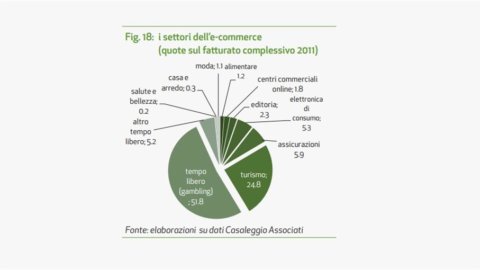Far from over, the crisis has reached its peak and Italian consumers know it well. 2012 will see the fifth consecutive year of erosion of real disposable income with a consequent drop in consumer spending of 2,8%. In this way we reach lower levels than in 2007 mainly due to "decreasing expectations", ie a sustained decline in the main confidence indicators of Italian households. This was revealed by the latest survey on consumption by the Prometeia research centre.
IT IS NOT A COUNTRY FOR YOUNG PEOPLE… – Le people between 50 and 64 are the least confident about the present condition, while the youngest, especially the under 29s, reveal the greatest pessimism about future prospects. And, judging by Prometeia's data, they are not entirely wrong. Between 2006 and 2010, the disparities between generations increased significantly: the incomes of individuals under the age of 55 have decreased, while those of the elderly have increased, reaching a gap of 26% in 2010. Compared to 2008, with the exception of retirees, the only category to have increased their real income was that of managers-executives, represented by over 50% of workers over 45 years of age.
…NOR FOR IMMIGRANTS – From 2001 to 2009 the number of foreigners residing in Italy almost tripled (from 2,3% to 6,3%) which partly compensated for the natural balance of the population now in negative territory. Above all, the presence of minors of foreign origin and second generations has increased by over a third. But the increase in social diversity has not been accompanied by greater social mobility for them and, despite the higher labor participation rate, immigrant incomes remain lower than the national average.
SINGLE PARENTAL AND SINGLE FAMILIES – The increase in the number of one-piece cores (single, separated, widowed, divorced) results in a shift towards new consumption trends more correlated to the sphere of individual affirmation: from smaller and more functional apartments, to smaller and more ready-to-use food packages, up to cheaper home care products and entertainment. The number of single parents, particularly in the under 35 segment: in 2010 they represent more than 8% of the total. Furthermore, fewer and fewer couples decide to have children: only 37% of the total.
– At least in the sign of the genre, good news. In 2011, women outnumbered men in holding higher education qualifications with a percentage of total graduates of 54% respectively. However, there is still a strong gender gap in lower education levels (more than 50% of the female population does not pass the middle school certificate). However, according to Prometeia, "the growth in the number of female graduates, the higher rate of labor participation and the gradual modernization of lifestyles and late motherhood identify in active female population one of the main drivers of consumption over the next few years, especially in the younger unmarried bracket".
CRISIS and BUSINESS ONLINE – The crisis has stimulated the invective of many Italians who are moving in search of cheaper purchasing opportunities. While on the one hand purchases at discount stores and outlets are increasing, thePurchase online has experienced remarkable growth: the percentage of individuals using this method of purchase has doubled since 2005 and, in 2011 it stood at 26%. In the same year, the sales turnover on the network was 19 billion euros. The most popular sectors are the free time, mainly in the segment of gambling, and . E-commerce has also experienced dynamic growth in electronics, apparel and publishing. In fact, across all age groups, reading of newspapers and magazines on the Web is growing. According to Prometeia's analysis, the development of e-commerce will be fueled by the expansion of the "mobile way" to the market: the smartphone is increasingly the protagonist within the purchasing process, facilitated by the forthcoming introduction on the market of smart cards, credit cards incorporated in the mobile phone sim.
INTERNET and SOCIAL NETWORKS – As regards the penetration of the Internet in the area, the Connectivity Scorecard places Italy in twenty-second position, behind Portugal. The country is penalized by infrastructural weakness and the still limited use by the population of public and private services on the network. However the increase in the percentage of the population using the Web in Italy it was remarkable: from 25% at the beginning of the 46s to 2010% in XNUMX. According to Prometeia, giving hope for a reduction of the gap with the other European countries is "the pervasive diffusion that is affecting tablet and smartphone” – in 2011 in Italy in 1 and 21 million units respectively (sources Ipsos, Nielsen 2011) – which is developing a process of cultural digitization. The use of mobile devices is also widespread among older age groups, with a penetration rate of 89.5% on the overall population. Not to mention the high participation in social networks: Italy is the eleventh country in the world for Facebook diffusion in 2011.
FOOD GOODS – In the face of the growing weakness of disposable income and the increase in inflationary pressure, a marked trend towards sober consumption has emerged. In the food sector, the reduction in waste has been considerable: attention to quality remains a priority but recourse to promotional initiatives and private label products has increased. In addition, a growing attention to the sphere of health and the search for time saving products with a shift in consumption from the fresh to the packaged area, and from traditional goods to those evolved in terms of quality and service content, such as organic, frozen and pre-cooked products. Other segments (ethnic foods, specific foods for intolerances) may also show a good trend over the forecast period.
FIXED LIVING EXPENSES – This entry matches almost a third of the household non-food consumption basket Italian. Prometeia estimates that the burden of forced consumption will grow further in the next few years – also in relation to the prescriptions of fiscal maneuvers – by continuing to drain economic resources to the detriment of more desirable consumption.
Attachments: Prometeia_Italian consumption beyond the crisis.pdf




